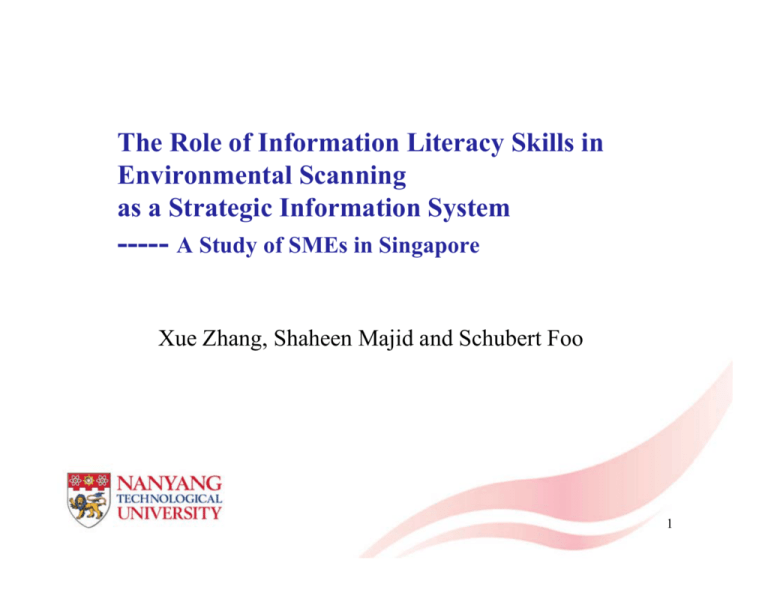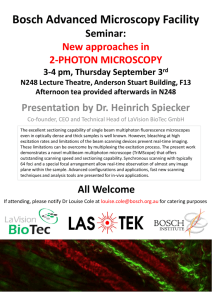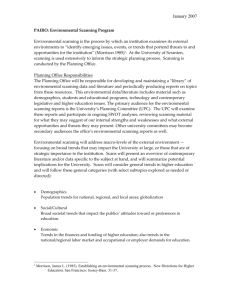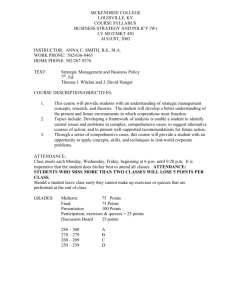The role of information literacy in environmental scanning as a
advertisement

The Role of Information Literacy Skills in Environmental v o e Scanning Sc g as a Strategic Information System ----- A Study of SMEs in Singapore X Zhang, Xue Zh Sh h Shaheen Majid M jid and dS Schubert h b tF Foo 1 Outline Introduction Literature Review Problem Statement, Research Questions and Objectives Proposedd Research h Models d l Proposed Research Methodology Significance of the Research Conclusion 2 Outline Introduction Background Information Definition of Key Terms Scope of the Research Literature Review Problem Statement, Research Questions and Objectives Proposed Research Models Proposed Research Methodology Significance g of the Research Conclusion 3 Background Information Advancement of ICT Rapid Changes and Emerging Trends Environmental Scanning Business Organizations Large Firms Non-profit Organizations SMEs 4 What is Environmental Scanning? A strategic information system adopted by organizations to deal with externall environmental i l information, i f i the h products d off which hi h would ld assist i decision-makers for tactical and strategic decision making (Aguilar, 1967; Choo, 1993). Environmental Scanning Process Scanning Need Identification Information Collection Information Organization & Storage Info Processing & Synthesizing Information Distribution Info Evaluation & Use 5 I f Information ti Literacy Lit Skill Skills The abilities of individuals in defining, locating, selecting, organizing, presenting and evaluating information (Goad, presenting, (Goad 2002; Todd, Todd Lamb, Lamb & McNicholas, McNicholas 1992), which are the key competencies required to conduct different ES activities. Information System An organized procedure for collecting, processing, storing, and retrieving information to satisfy a variety of needs, as stated in Harrod's Librarians' glossary (1995). It could be either paper-based or computer-based. 6 g p SMEs Scope of the Research ----- Singapore ES is a concept originally raised for large business corporations. SMEs are more sensitive towards environmental uncertainties. SMEs form a significant chunk of the local economy. 7 Singapore SMEs For Singapore, Singapore SMEs are generally defined as having at least 30% local equity, fixed productive assets (defined as net book value of factory building machinery and equipment) not exceeding $15 million, building, million and employment size not exceeding 200 workers for nonmanufacturing companies (SME Portal Singapore, Singapore 2009). 2009) Of the about 160,000 enterprises in 2007, 99% were SMEs. These SMEs employed nearly 6 out of every 10 workers and generated almost half of total enterprises’ value-added (DOS Singapore, 2007). 8 Outline Introduction Literature Review Information Literacy in the Workplace Environmental Scanning as a Strategic Information System Information Literacy and Environmental Scanning Problem Statement, Research Questions and Objectives Proposed Research Models Proposed Research Methodology Significance of the Research C l i Conclusion 9 Information Literacy in the Workplace The importance of IL skills for business organizations is highlighted in the literature (Drucker,1992; Mutch, 1997; Karim and Hussein, 2008). Employees in the workplace found to be lack of IL skills (Bruce, 1999; O'Sullivan, 2002; Cheuk, 2002). Few IL studies have integrated IL skills with a specific business management activity, and even fewer of them have tried to evaluate the impact p of IL on real business applications. pp 10 Environmental Scanning as a Strategic Information System Strategic Information System Systems designed to acquire, process, store, organize, disseminate information regarding external opportunities and threats, and make such information available for strategic use (Feather & Sturges, Sturges 2003). Environmental Scanning for Coping with Uncertainty (Daft et al, 1988) Sector Sector Importance Sector Complexity Sector Variability Perceived Sector Sector Uncertainty Perceived Strategic Uncertainty Scanning Scanning Frequency Scanning g Mode 11 Measurement of Perceived i Strategic i Uncertainty i and Environmental Scanning Measurement PSU PI × (C+R) (Auster & Choo, 1993; Daft et al., 1988; Ebrahimi, 2000; Stewart, May, & Kalia, 2008) ES AVAIL & PREDICT EU × I Rate by levels (Elenkov, 1997b) (Olsen et al., 1994; Hough & White, 2004) (Boynton, Gales and Blackburn,1993) Frequency of scanning & Degree of interest Use of info sources Scope of scanning Type and role of scanning unit (Hambrick, 1982; Boyd & Fulk, 1996; Strandholm & Kumar, 2003; McGee & Sawyerr, Sawyerr 2003) (Brush, 1992; Daft et al., 1988; May et al., 2000; Stewart et al al., 2008) (Beal, 2000; Strandholm & Kumar 2003) Kumar, (Olsen et al., 1994) 12 Information Literacy Skills at each Step of Environmental Scanning Identification of Organization Organization’ss Scanning Needs • Identify their own information need clearly; • Possessing essential communication skills to express their needs; • Capable C bl in i information i f ti processing i andd synthesizing, th i i andd conclude l d the th organization’s scanning need. Information Acquisition • Select l the h most appropriate i sources (quality ( li & cost); ) • Formulate a suitable search strategy. Information Organization and Storage • Ensure the effectiveness and efficiency of the system (creation of taxonomies, resource description and comprehensiveness) 13 Information Literacy Skills at each Step of Environmental Scanning Information Processing and Synthesizing • Information Processing Skills (Filtering, Synthesizing…) • Familiar with Analytical y Tools and Techniques q Information Distribution • Right information to the right person at the right time in a right format Information Evaluation and Use • Evaluate the quality of information (Sufficient, Adequate, Timely…) • Process and Synthesize based on real-time situation 14 Outline Introduction Literature Review Problem Statement, Research Questions and Objectives Proposedd Research h Models d l Proposed Research Methodology Significance of the Research Conclusion 15 Problem Statement In prior ES literature, besides information acquisition, insufficient attention has been paid to the other steps of ES. IL skills kill and d organization’s i ti ’ information i f ti system, t as enablers bl t to conduct effective ES activities, have not been highlighted in previous studies. It is, therefore, desirable to study environmental scanning as a systematic process with the role of information literacy skills and information technology applications investigated. 16 Research Questions RQ1: With different degree of perceived strategic uncertainty, uncertainty what are the current practices and impact of the whole valuechain of environmental scanning process of SMEs in Si Singapore? ? RQ2: Q What is the role,, contribution,, and to what extent have information literacy skills and information technology applications being effectively embraced in environmental scanningg pprocess as a strategic g information system? y 17 Research Objectives RO1: To find out the relationships among perceived strategic uncertainty and environmental scanning process; RO2: To discover how the use of information literacy skills and information technology applications can enhance the effectiveness of environmental scanning; RO3: To propose and verify a framework showing the relationships among perceived strategic uncertainty, environmental scanning process and organizational performance with the role of information literacy skills and information technologies and applications investigated. 18 Outline Introduction Literature Review Problem Statement, Research Questions and Objectives Proposedd Research h Models d l Proposed Research Methodology Significance of the Research Conclusion 19 PSU, Step-based ES and Organizational Performance Actual Effectiveness of ES Actual Effectiveness of ES Actual Level of IL Skills Actual Effectiveness of Tech & Media Actual Effectiveness of each ES Step Perceived Effectiveness of ES Perceived Level of IL Skills Perceived Effectiveness of Tech & Media Sector C Complexity l it Sector Variability Perceived Sector Uncertainty Perceived Sector Sector Importance Perceived Strategic Uncertainty Perceived Effectiveness of each ES Step Implemented Frequency of each ES Step Perceived Strategic Uncertainty Rate of Interest for each ES Step Actual ES Product Implemented ES Process 20 Actual Effectiveness of ES Actual Level of Actual Level of IL Skills Actual Access to Info Sources Actual Effectiveness of Tech & Media Actual Effectiveness of each ES Step Perceived Effectiveness of ES Perceived Access to Info Sources Sector Complexity Sector Variability Perceived Level Perceived Level of IL Skills Perceived Effectiveness of Tech & Media Perceived Sector Uncertainty Perceived Sector Importance Perceived Strategic Uncertainty Perceived Effectiveness of each ES Step Perceived Strategic Uncertainty Implemented Frequency of each ES Step PSU, Info Collection and O Organizational i i l Performance Actual ES Product Rate of Interest for each ES Step Implemented ES Implemented ES Process 21 Outline Introduction Lit t Literature Review R i Problem Statement, Research Questions and Objectives p Research Models Proposed Proposed Research Methodology Proposed Research Methods Proposed Sample Selection and Characteristics Proposed Survey Instrument and Interview Method Significance of the Research Conclusion l i 22 Proposed Research Methods Quantitative Method through Questionnaire Survey/Test Collect data to obtain a broad picture of how Singapore SMEs scan their environment; Enable respondents to report their perceptions while remaining anonymous and honest on the feedback; Statistically investigate the relationships proposed . Qualitative Method through Face Face-to-Face to Face Interview Gather more profound data with staff engaged in ES activities with different functional roles from various hierarchical levels; Explore p more about the ES activities conducted byy the same company p y under different time period through recall of various strategic situations; 23 Proposed Sample Selection and Characteristics Only 2 Industries are proposed to be included Travel agent companies Food manufactures Survey: S “C i i Sampling” “Criterion S li ” off Singapore Si SME SMEs Company manpower: 50 to 200 employees. Concentrating on a single business domain without operating across different industries. Interview CEOs and staff engaged in ES of 2 leading companies from each of the 2 industries 24 Outline Introduction Literature Review Problem Statement, Research Questions and Objectives Proposedd Research h Models d l Proposed Research Methodology Significance of the Research Conclusion 25 Significance of the Research From a Theoretical Perspective This research aims to address the knowledge gaps and build up a new model of ES as a systematic process with consideration of the effect of IL skills and information technology applications. From a Practical Perspective Provide insights into the current situations of SMEs in Singapore regarding their use of IL skills and information technology for ES; Reveal their ES mechanisms, detect the problems they may encountered, and generate implications on how to improve the current situation. From a Methodological Perspective Explore the feasibility of adopting both quantitative and qualitative methods to generate a quality set of findings and to cross validate them. 26 C l i Conclusion Th The common limitations li i i off prior i studies di have h b been addressed dd d in i the proposed model through the equal attention paid to each ES step and the newly added variables. The proposed research design expects to enrich this set of information by obtaining inputs across the hierarchy of the organization, i i thereby h b providing idi a richer i h and d more accurate picture of ES by the various stakeholders involved in this process. 27 28








